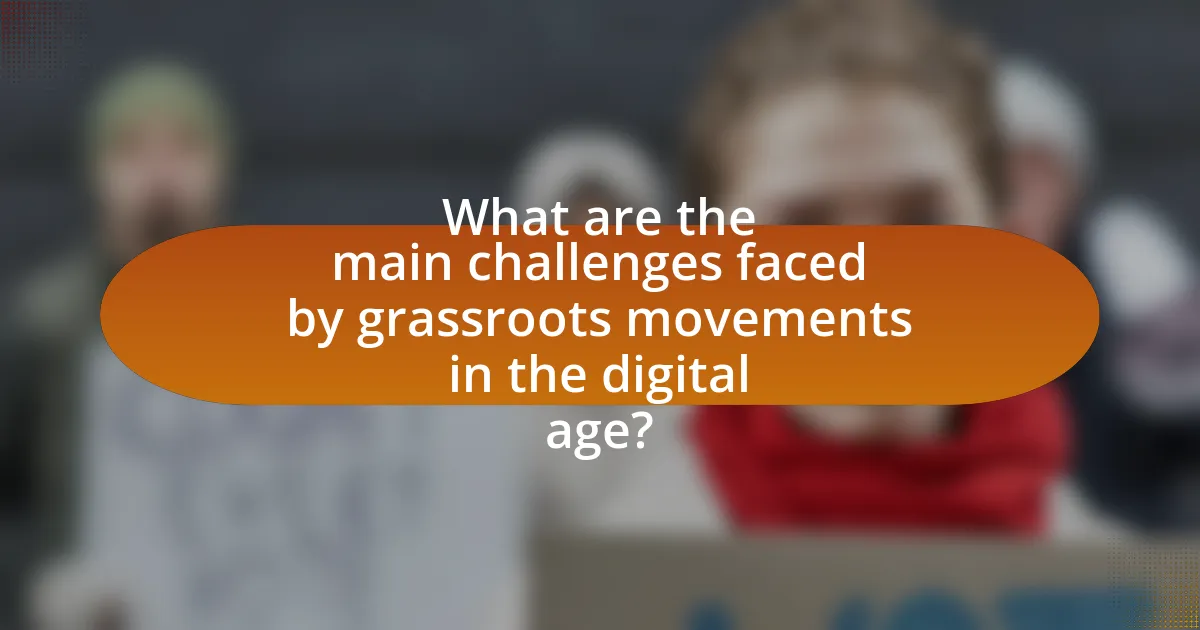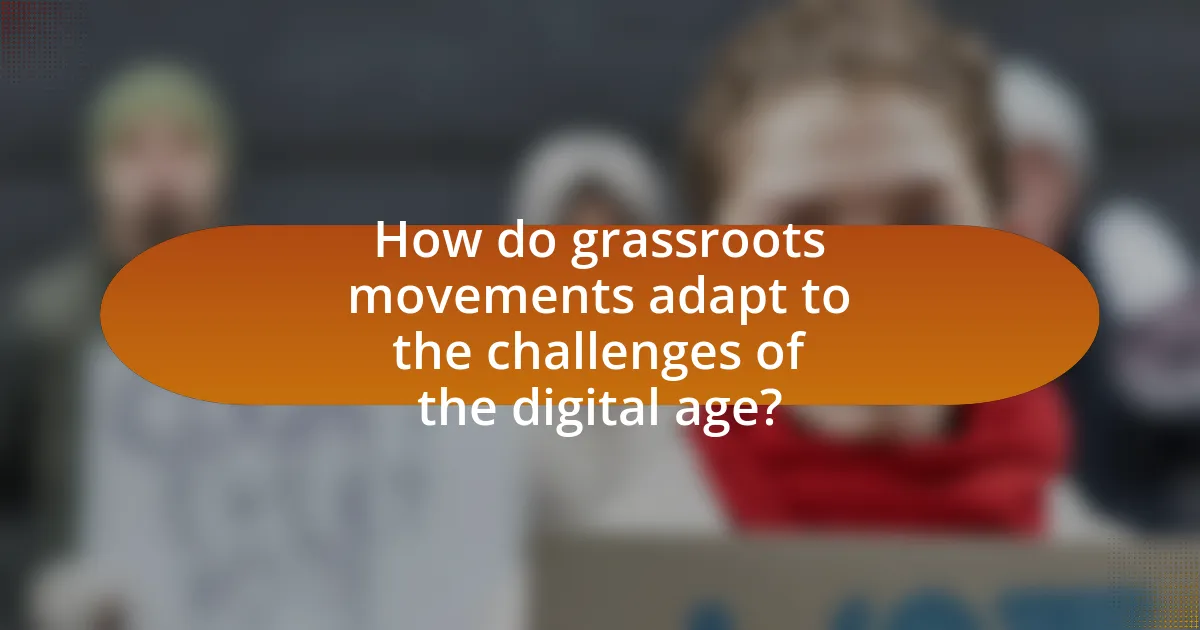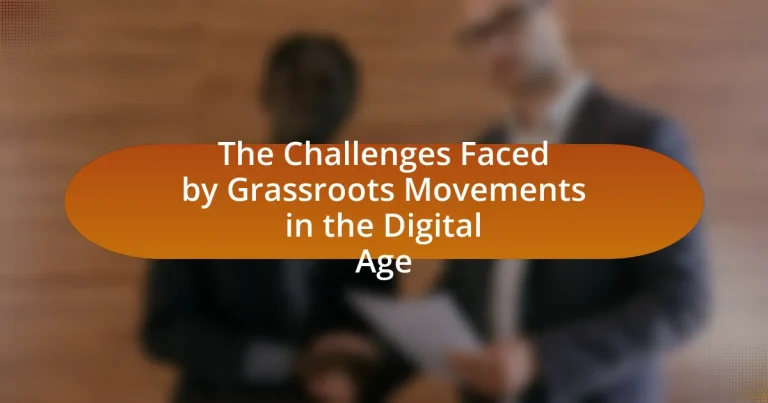Grassroots movements in the digital age encounter significant challenges, including information overload, digital surveillance, and the fragmentation of online communities. These obstacles complicate their ability to organize and communicate effectively. Technology has transformed grassroots activism by enhancing communication and mobilization, yet it also presents issues such as algorithmic bias and misinformation. The article explores how grassroots movements adapt to these challenges, leverage digital tools for outreach, and maintain authenticity while building community in a digital environment. Additionally, it examines future trends and practical strategies for grassroots movements to thrive amidst evolving digital landscapes.

What are the main challenges faced by grassroots movements in the digital age?
Grassroots movements in the digital age face several main challenges, including information overload, digital surveillance, and the fragmentation of online communities. Information overload occurs as activists struggle to capture attention amidst a vast amount of content, making it difficult to convey their messages effectively. Digital surveillance poses a risk to privacy and security, as movements may be monitored by governments or corporations, leading to potential repression. Additionally, the fragmentation of online communities can dilute collective action, as diverse platforms and social media algorithms create echo chambers that hinder broader mobilization. These challenges complicate the ability of grassroots movements to organize, communicate, and achieve their goals in a rapidly evolving digital landscape.
How has technology changed the landscape for grassroots movements?
Technology has significantly transformed grassroots movements by enhancing communication, mobilization, and fundraising capabilities. Social media platforms like Twitter and Facebook allow grassroots organizations to reach wider audiences quickly, facilitating real-time information sharing and community engagement. For instance, the #BlackLivesMatter movement utilized social media to organize protests and raise awareness, demonstrating how digital tools can amplify voices and foster solidarity. Additionally, crowdfunding platforms have enabled grassroots movements to secure funding from a global audience, reducing reliance on traditional funding sources. According to a report by the Pew Research Center, 69% of Americans believe social media is an effective tool for activism, highlighting its impact on public perception and participation in grassroots efforts.
What role does social media play in grassroots mobilization?
Social media serves as a crucial tool for grassroots mobilization by facilitating rapid communication, organization, and engagement among supporters. It enables grassroots movements to disseminate information quickly, rally participants for events, and create a sense of community among individuals who share common goals. For instance, during the Arab Spring, platforms like Twitter and Facebook were instrumental in organizing protests and spreading awareness, demonstrating how social media can amplify grassroots efforts and mobilize large groups effectively.
How do digital tools enhance or hinder grassroots efforts?
Digital tools enhance grassroots efforts by increasing accessibility, facilitating communication, and amplifying outreach. For instance, social media platforms allow grassroots organizations to connect with a wider audience, mobilize supporters quickly, and share information efficiently. According to a study by the Pew Research Center, 69% of adults in the U.S. use social media, which provides a significant channel for grassroots movements to engage with potential supporters and disseminate their messages rapidly.
Conversely, digital tools can hinder grassroots efforts by creating barriers such as digital divides and misinformation. Not all community members have equal access to technology, which can exclude marginalized groups from participating fully. Additionally, the spread of misinformation on digital platforms can undermine the credibility of grassroots movements, as seen during various social movements where false narratives have led to confusion and division among supporters. Thus, while digital tools offer powerful advantages for grassroots organizing, they also present significant challenges that can impact the effectiveness of these efforts.
What are the specific obstacles grassroots movements encounter online?
Grassroots movements encounter several specific obstacles online, including algorithmic bias, misinformation, and digital surveillance. Algorithmic bias can limit the visibility of grassroots content on social media platforms, as algorithms often prioritize mainstream narratives over grassroots initiatives. Misinformation campaigns can undermine the credibility of these movements, making it difficult for them to communicate their messages effectively. Additionally, digital surveillance poses a threat to the privacy and security of activists, potentially deterring participation and engagement. These challenges are supported by research indicating that social media algorithms favor established voices, while studies show that misinformation can significantly impact public perception and trust in grassroots efforts.
How do issues of digital divide affect grassroots participation?
Issues of the digital divide significantly hinder grassroots participation by limiting access to digital tools and platforms essential for organizing and mobilizing communities. Individuals without reliable internet access or digital literacy are less able to engage in online advocacy, share information, or connect with broader movements. For instance, a 2021 report by the Pew Research Center indicated that 27% of adults in the U.S. do not have access to high-speed internet, which directly impacts their ability to participate in digital campaigns or online discussions. Consequently, this exclusion perpetuates inequalities in representation and diminishes the overall effectiveness of grassroots movements.
What challenges do grassroots movements face regarding misinformation?
Grassroots movements face significant challenges regarding misinformation, primarily due to the rapid spread of false information through social media platforms. This misinformation can undermine the credibility of these movements, confuse supporters, and divert attention from their core messages. For instance, a study by the Pew Research Center found that 64% of Americans believe that misinformation has caused confusion about important issues, which directly impacts grassroots efforts that rely on clear communication to mobilize support. Additionally, grassroots movements often lack the resources to effectively counteract misinformation campaigns, making it difficult for them to maintain their narratives in the face of widespread falsehoods.

How do grassroots movements adapt to the challenges of the digital age?
Grassroots movements adapt to the challenges of the digital age by leveraging social media platforms for organization, outreach, and mobilization. These movements utilize tools like Facebook, Twitter, and Instagram to disseminate information rapidly, engage supporters, and coordinate actions, which enhances their visibility and impact. For instance, the Black Lives Matter movement effectively used Twitter to spread awareness and organize protests, demonstrating the power of digital communication in grassroots activism. Additionally, grassroots movements employ data analytics to understand public sentiment and tailor their strategies accordingly, allowing them to respond more effectively to challenges and opportunities in real-time.
What strategies do grassroots movements employ to overcome digital challenges?
Grassroots movements employ strategies such as leveraging social media, building coalitions, and utilizing digital storytelling to overcome digital challenges. By effectively using social media platforms, these movements can reach wider audiences, mobilize supporters, and disseminate information rapidly. For instance, the Black Lives Matter movement utilized Twitter and Instagram to amplify their message and organize protests, demonstrating the power of social media in grassroots activism. Additionally, forming coalitions with other organizations enhances resource sharing and strengthens their digital presence. Digital storytelling allows grassroots movements to humanize their causes, making them more relatable and engaging, which can increase support and participation. These strategies collectively enable grassroots movements to navigate and mitigate the obstacles posed by the digital landscape.
How can grassroots movements leverage technology for effective outreach?
Grassroots movements can leverage technology for effective outreach by utilizing social media platforms, email campaigns, and mobile applications to engage and mobilize supporters. Social media enables these movements to reach a broader audience quickly; for instance, platforms like Facebook and Twitter allow for real-time communication and sharing of information, which can amplify their message. Email campaigns can target specific demographics, providing tailored content that resonates with different groups, thereby increasing engagement rates. Additionally, mobile applications can facilitate grassroots organizing by enabling supporters to receive updates, participate in events, and connect with one another, enhancing community building. According to a 2020 report by the Pew Research Center, 69% of Americans use social media, highlighting its potential as a powerful tool for outreach.
What are the best practices for combating misinformation in grassroots campaigns?
The best practices for combating misinformation in grassroots campaigns include establishing clear communication channels, promoting media literacy, and engaging in fact-checking. Grassroots organizations should create official platforms for disseminating accurate information, which helps counter false narratives. Promoting media literacy among supporters empowers individuals to critically evaluate information sources, reducing the spread of misinformation. Additionally, engaging in proactive fact-checking and collaborating with reputable fact-checking organizations can help identify and correct false claims swiftly. Research indicates that campaigns that actively address misinformation can significantly improve public trust and engagement, as demonstrated by studies showing that transparency and responsiveness enhance credibility in grassroots movements.
How do grassroots movements build community in a digital environment?
Grassroots movements build community in a digital environment by leveraging social media platforms and online communication tools to connect individuals with shared interests and goals. These movements utilize platforms like Facebook, Twitter, and Instagram to disseminate information, mobilize supporters, and foster engagement through interactive content such as live streams, polls, and discussions. For instance, the Black Lives Matter movement effectively used Twitter to organize protests and share resources, demonstrating the power of digital connectivity in rallying community support. Additionally, online forums and group chats facilitate ongoing dialogue and collaboration among members, reinforcing a sense of belonging and collective identity. This digital engagement is crucial, as studies show that online communities can enhance participation and activism, making grassroots movements more resilient and impactful in addressing social issues.
What role do online platforms play in fostering community engagement?
Online platforms play a crucial role in fostering community engagement by providing accessible spaces for interaction, collaboration, and information sharing. These platforms enable individuals to connect over shared interests, mobilize for causes, and organize events, thereby enhancing community cohesion. For instance, social media networks like Facebook and Twitter facilitate real-time communication and allow grassroots movements to reach wider audiences, as evidenced by the rapid mobilization seen during events like the Arab Spring, where online platforms were instrumental in organizing protests and disseminating information. Additionally, research from the Pew Research Center indicates that 69% of adults in the U.S. use social media, highlighting its significance as a tool for community engagement and activism.
How can grassroots movements maintain authenticity in digital spaces?
Grassroots movements can maintain authenticity in digital spaces by prioritizing transparency and community engagement. Transparency involves openly sharing decision-making processes, funding sources, and organizational goals, which fosters trust among supporters. Community engagement is achieved through active participation, allowing members to voice their opinions and contribute to discussions, ensuring that the movement reflects the collective values and experiences of its base. Research indicates that movements that emphasize these principles are more likely to sustain credibility and support, as seen in the success of campaigns like Black Lives Matter, which effectively utilized social media to amplify grassroots voices while remaining accountable to their community.

What future trends may impact grassroots movements in the digital age?
Future trends that may impact grassroots movements in the digital age include the rise of artificial intelligence, increased data privacy regulations, and the growing influence of social media algorithms. Artificial intelligence can enhance grassroots organizing by enabling more effective targeting of messages and mobilization efforts, as seen in campaigns that utilize data analytics to identify potential supporters. Increased data privacy regulations, such as the General Data Protection Regulation (GDPR) in Europe, may limit the ability of grassroots movements to collect and utilize personal data for outreach, potentially hindering their effectiveness. Additionally, social media algorithms increasingly dictate what content is seen by users, which can either amplify grassroots messages or suppress them, depending on the platform’s policies and user engagement patterns. These trends collectively shape the landscape in which grassroots movements operate, influencing their strategies and overall impact.
How might emerging technologies influence grassroots activism?
Emerging technologies significantly influence grassroots activism by enhancing communication, mobilization, and resource allocation. For instance, social media platforms enable activists to reach wider audiences quickly, facilitating the rapid dissemination of information and rallying support for causes. According to a study by the Pew Research Center, 69% of adults in the U.S. use social media, which has become a vital tool for organizing protests and campaigns. Additionally, technologies such as crowdfunding platforms allow grassroots movements to secure funding directly from supporters, bypassing traditional financial barriers. This democratization of resources empowers smaller organizations to compete with larger entities, thereby amplifying their impact in the digital age.
What potential do blockchain and decentralized platforms hold for grassroots movements?
Blockchain and decentralized platforms hold significant potential for grassroots movements by enhancing transparency, security, and community engagement. These technologies enable grassroots organizations to operate without centralized control, allowing for direct peer-to-peer interactions and funding through mechanisms like cryptocurrencies and smart contracts. For instance, the use of blockchain can ensure that donations are tracked and utilized as intended, which builds trust among supporters. Additionally, decentralized platforms can facilitate the organization of events and mobilization efforts without reliance on traditional social media, which may censor or limit reach. This was evidenced by the use of blockchain in the 2020 U.S. elections, where organizations utilized it to ensure voter integrity and transparency in grassroots campaigns.
How can artificial intelligence be utilized to support grassroots initiatives?
Artificial intelligence can be utilized to support grassroots initiatives by enhancing data analysis, improving communication, and optimizing resource allocation. For instance, AI algorithms can analyze community needs and preferences through social media sentiment analysis, enabling grassroots organizations to tailor their strategies effectively. Additionally, AI-driven chatbots can facilitate real-time communication between grassroots movements and their supporters, increasing engagement and mobilization. Research from the Stanford Social Innovation Review highlights that AI tools can streamline fundraising efforts by identifying potential donors based on behavioral patterns, thus maximizing financial support for grassroots initiatives.
What lessons can grassroots movements learn from past digital campaigns?
Grassroots movements can learn the importance of strategic messaging and audience engagement from past digital campaigns. For instance, the Ice Bucket Challenge effectively utilized social media to create viral content, raising over $115 million for ALS research in just a few months. This demonstrates that clear, relatable messaging can mobilize support and drive donations. Additionally, grassroots movements should recognize the value of data analytics, as seen in the Obama 2008 campaign, which used targeted outreach based on voter data to increase participation. These examples highlight that understanding audience demographics and preferences can enhance campaign effectiveness.
What are the key takeaways from successful grassroots movements in the digital era?
Successful grassroots movements in the digital era demonstrate the importance of leveraging social media for rapid mobilization and community engagement. These movements effectively utilize platforms like Twitter and Facebook to disseminate information quickly, rally support, and create a sense of community among participants. For instance, the Black Lives Matter movement gained significant traction through viral hashtags and online campaigns, illustrating how digital tools can amplify voices and drive social change. Additionally, successful movements often emphasize inclusivity and diversity, ensuring that various perspectives are represented, which enhances their legitimacy and reach. Data from the Pew Research Center indicates that 69% of Americans use social media, highlighting its potential as a powerful tool for grassroots organizing.
How can grassroots movements prepare for future digital challenges?
Grassroots movements can prepare for future digital challenges by adopting robust digital literacy programs and enhancing their online security measures. Digital literacy enables activists to effectively navigate social media platforms, utilize data analytics for outreach, and counter misinformation, which is crucial as 70% of Americans use social media for news, according to the Pew Research Center. Additionally, implementing strong cybersecurity protocols protects sensitive information and maintains trust within the community, especially as cyberattacks on organizations have increased by 400% since 2020, as reported by Cybersecurity Ventures. By focusing on these areas, grassroots movements can build resilience against evolving digital threats.
What practical tips can grassroots movements implement to thrive in the digital age?
Grassroots movements can thrive in the digital age by leveraging social media platforms for outreach and engagement. Utilizing platforms like Facebook, Twitter, and Instagram allows these movements to connect with a broader audience, share their messages, and mobilize supporters quickly. For instance, the Black Lives Matter movement effectively used Twitter to organize protests and raise awareness, demonstrating the power of digital communication in grassroots activism. Additionally, creating compelling visual content, such as infographics and videos, can enhance message retention and shareability, further amplifying their reach. Engaging in online communities and forums relevant to their cause can also foster collaboration and support, as seen in various environmental movements that have successfully mobilized online communities to advocate for policy changes.


